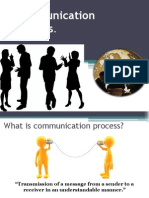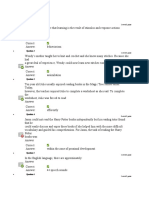0 ratings0% found this document useful (0 votes)
67 views Communication
Communication
Uploaded by
romeojrThis document discusses effective organizational communication. It begins by outlining the communication process, including the source encoding a message, choosing a channel to send it through, the receiver decoding the message, and feedback. It then covers forms of communication like oral, written, and nonverbal. Direction of communication in organizations can be vertical or lateral. Organizational communication can occur through formal and informal networks. Barriers to communication and the results of communication failures are also examined. The document concludes with principles for good information and discusses whether perfect communication is attainable.
Copyright:
© All Rights Reserved
Available Formats
Download as PDF, TXT or read online from Scribd
Communication
Communication
Uploaded by
romeojr0 ratings0% found this document useful (0 votes)
67 views30 pagesThis document discusses effective organizational communication. It begins by outlining the communication process, including the source encoding a message, choosing a channel to send it through, the receiver decoding the message, and feedback. It then covers forms of communication like oral, written, and nonverbal. Direction of communication in organizations can be vertical or lateral. Organizational communication can occur through formal and informal networks. Barriers to communication and the results of communication failures are also examined. The document concludes with principles for good information and discusses whether perfect communication is attainable.
Original Description:
communication
Copyright
© © All Rights Reserved
Available Formats
PDF, TXT or read online from Scribd
Share this document
Did you find this document useful?
Is this content inappropriate?
This document discusses effective organizational communication. It begins by outlining the communication process, including the source encoding a message, choosing a channel to send it through, the receiver decoding the message, and feedback. It then covers forms of communication like oral, written, and nonverbal. Direction of communication in organizations can be vertical or lateral. Organizational communication can occur through formal and informal networks. Barriers to communication and the results of communication failures are also examined. The document concludes with principles for good information and discusses whether perfect communication is attainable.
Copyright:
© All Rights Reserved
Available Formats
Download as PDF, TXT or read online from Scribd
Download as pdf or txt
0 ratings0% found this document useful (0 votes)
67 views30 pages Communication
Communication
Uploaded by
romeojrThis document discusses effective organizational communication. It begins by outlining the communication process, including the source encoding a message, choosing a channel to send it through, the receiver decoding the message, and feedback. It then covers forms of communication like oral, written, and nonverbal. Direction of communication in organizations can be vertical or lateral. Organizational communication can occur through formal and informal networks. Barriers to communication and the results of communication failures are also examined. The document concludes with principles for good information and discusses whether perfect communication is attainable.
Copyright:
© All Rights Reserved
Available Formats
Download as PDF, TXT or read online from Scribd
Download as pdf or txt
You are on page 1of 30
EFFECTIVE
ORGANISATIONAL
COMMUNICATION
BY:
DIANA O. AYORKOR ADJEI
COMMUNICATION QUIZ
Test Your Communication Skills?
OUTLINE OF
PRESENTATION
• Introduction
• Communication Process
• Forms of Communication
• Organizational Communication
• Direction of Communication
• Barriers To Effective Communication
• Conclusion
Introduction
Communication is a natural process that involves
at least two living things.
Communication skills are some of the most
important skills that we need to succeed in the
workplace.
Communication in an organization, therefore, is a
process that involves at least two people – a
sender and a receiver. For it to be successful, the
receiver must understand the message in the way
that the sender intended.
Communication Process
THE SOURCE –
PLANNING YOUR MESSAGE
The Source Cont’d
To Plan your communication:
• Understand your objective. Why are you
communicating?
• Understand your audience. With whom are you
communicating? What do they need to know?
• Plan what you want to say, and how you'll send
the message.
• Good communicators use the KISS ("Keep It Simple
and Straightforward") principle. They know that less
is often more, and that good communication should
be efficient as well as effective.
ENCODING
ENCODING
CREATING A CLEAR, WELL-CRAFTED MESSAGE
The source/sender initiates the process by
encoding a thought.
When you know what you want to say, decide exactly
how you'll say it. You're responsible for sending a
message that's clear and concise.
The message is the actual physical product of
the sender’s encoding
PRODUCT – Speech; Written words; Gestures
CHOOSING THE RIGHT CHANNEL
Along with encoding the message, it is important to
choose the best communication channel to send it.
You have to be efficient, and make the most of
your communication opportunity.
In determining the best way to send a message, we
should consider the following:
• The sensitivity and emotional content of the subject.
• How easy it is to communicate detail.
• The receiver's preferences.
• Time constraints.
• The need to ask and answer questions.
DECODING
RECEIVING AND INTERPRETING A MESSAGE
DECODING – RECEIVING AND
INTERPRETING A MESSAGE
The Recipient/Decoder is the person/people
for whom the message is intended. They
receive the message and decode it. For an
effective communication to take place, it is
necessary that the recipient of the message
understands the message the way the sender
intended.
Both the sender and the recipient do have
important roles to play in completing the
process of effective communication.
FEEDBACK
Feedback is response from the receiver. Without it, you
can't be sure that people have understood your message.
Feedback can be verbal or non-verbal, including body
language .
By watching the facial expressions, gestures, and posture
of the person you're communicating with, you can spot:
• Confidence levels.
• Defensiveness.
• Agreement.
• Comprehension (or lack of understanding).
• Level of interest, e.t.c
KEY NOTES
As either a speaker or a listener, or as a writer or a
reader, you're responsible for making sure that the
message is communicated accurately. Pay attention to
words and actions, ask questions, and watch body
language. These will all help you ensure that you say
what you mean, and hear what is intended.
A properly encoded message should be correctly
decoded by the recipient.
A properly decoded message is clear, complete and not
be confusing.
An important aspect of encoding is knowing your
audience.
FORMS OF COMMUNICATION
How do group members transfer meaning between and
among each other?(Interpersonal Communication)
How do we communicate?
• We talk to people face to face, and we listen when people
talk to us; oral communication
• We write emails, memos, letters, newsletters and reports,
and we read the documents that are sent to us; written
communication
• Nonverbal Communication
DIRECTION OF COMMUNICATON
Communication can flow vertically or laterally.
• Vertical Communication: This is information
flow in a downward or upwards direction
• Lateral Communication: This is information
flow amongst members of the same work group,
managers at the same level, or any other
horizontally equivalent workers.
ORGANISATIONAL
COMMUNICATION
The exchange of information may be over formal
and informal channels/network. Formal networks
can however be very complicated, including
hundreds of people and a lot of hierarchical levels
depending on the size of organization.
ORGANISATIONAL
COMMUNICATION
ORGANISATIONAL
COMMUNICATION
Formal Small-Group Networks
Chain: this usually follows the formal chain of
command
Wheel: this relies on a central figure to act as a means
of conveying all group’s communication, usually a team
with a strong leader.
ORGANISATIONAL
COMMUNICATION
All channel: this network permits all group members to
actively communicate with each other
The Grapevine: this is the informal communication
network in a group or organization Recent studies
shows that word-of-mouth information from peers about
a company has a significant impact on the company.
ELECTRONIC COMMUNICATION
Communication in most organizations today is through
electronic means
Electronic communication: E-mail, instant messaging, text
messaging, video-conferencing.
Advantages of e-mail messages
E-mail messages can be written quickly, edited and stored
Distributed to one person or thousands of people same time
Recipients can read at their own convenience
Relatively cheaper than conventional methods
ELECTRONIC COMMUNICATION
E-mail messages has its own drawback and as managers, there
is the need to note the following key limitations
Disadvantages of using e-mail messaging
Misinterpreting the message
Communicating negative messages
Time-consuming nature of e-mails
• Don’t check e-mail in the morning
• Check in batches
• Unsubscribe
• Stop sending email
BARRIERS TO COMMUNICATION
• Filtering
• Selective Perception
• Information Overload
• Emotions
• Language
• Silence
• Communication Apprehension
/Social Anxiety
• Complex organizational structure
RESULTS OF COMMUNICATION
FAILURE
• Loss of Business/goodwill
• Waste of money and time
• Lowered productivity
• Poor co-ordination and control
• Frustration and hostility
• Dissatisfaction with others
• Lowered morale and loss of team spirit
• Conflict and arguments
• High employee turnover
CONCLUSION
Communication Trilogy
CONCLUSION
Seven Cs of good information
Clear
Concise
Concrete
Correct
Consistent
Complete
Considered Cross Cultural Factors
IS PERFECT COMMUNICATION
ATTAINABLE?
References
• Robbins S.P. & Judge T.A. (2012).
Essentials of Organizational Behavior. (11 th
ed.). Edinburgh Gate, Pearson Education
Limited
• www.mindtools.com
THANK
YOU
You might also like
- Cell Cycle Coloring KeyDocument3 pagesCell Cycle Coloring Keyromeojr80% (5)
- Training Management and Nfe: Group Iv Donnalyn Dela Cruz Charito L. Esmele Jeanette E. Borja Rolly VeronaDocument40 pagesTraining Management and Nfe: Group Iv Donnalyn Dela Cruz Charito L. Esmele Jeanette E. Borja Rolly VeronaCHARITO LOPEZ ESMELE100% (5)
- Business CommunicationDocument63 pagesBusiness CommunicationMark RiveraNo ratings yet
- EvacuationDrill PowerpointDocument19 pagesEvacuationDrill PowerpointromeojrNo ratings yet
- Emergency Preparedness and Response 110316Document61 pagesEmergency Preparedness and Response 110316romeojr100% (2)
- IBN ATAULLAH Al IIskandari - DEBATE WITH IBN TAYMIYYAHDocument7 pagesIBN ATAULLAH Al IIskandari - DEBATE WITH IBN TAYMIYYAHapi-200064100% (1)
- Effective Organisational Communication: Diana O. Ayorkor AdjeiDocument30 pagesEffective Organisational Communication: Diana O. Ayorkor Adjeikeshav181No ratings yet
- Effective Communication ProcessDocument34 pagesEffective Communication ProcesssiewspahNo ratings yet
- Business Communication - Chapter 1Document22 pagesBusiness Communication - Chapter 1londiwe.langa04No ratings yet
- Colarina - Communication in Teams and OrganizationsDocument45 pagesColarina - Communication in Teams and OrganizationsKaren So MundinNo ratings yet
- Communication Skills - Dr. Sanjay KeharDocument134 pagesCommunication Skills - Dr. Sanjay KeharNeeřąj ĶúmąřNo ratings yet
- CommunicationDocument38 pagesCommunicationNamrata PathakNo ratings yet
- En LBBT201603B Effective CommunicationDocument37 pagesEn LBBT201603B Effective CommunicationAsmahou Liliane Outman MoussaNo ratings yet
- Lecture One-Comm Process - 2018 To 2019Document22 pagesLecture One-Comm Process - 2018 To 2019daniloorestmarijaniNo ratings yet
- Communication Skills HandoutDocument54 pagesCommunication Skills HandoutTaopi100% (1)
- Effective Workplace CommunicationDocument20 pagesEffective Workplace CommunicationIqbalTawakalNo ratings yet
- Organizational Behavior: Chapter No 11 CommunicationDocument27 pagesOrganizational Behavior: Chapter No 11 Communicationsourav kumar rayNo ratings yet
- Chapter 15 - Managers and CommunicationDocument33 pagesChapter 15 - Managers and Communicationremino1100% (1)
- Significance of English in Official CommunicationDocument29 pagesSignificance of English in Official CommunicationsammmmNo ratings yet
- COMM80REVIEWERDocument11 pagesCOMM80REVIEWERJH arbee BartolomeNo ratings yet
- Understanding Organizational CommunicationDocument42 pagesUnderstanding Organizational CommunicationThe UniqueNo ratings yet
- Communication Process EffectiveDocument14 pagesCommunication Process EffectiveShrikant BaviskarNo ratings yet
- Concept of Managerial CommunicationDocument76 pagesConcept of Managerial CommunicationRajput KiransinhNo ratings yet
- Business Communiction SlideDocument96 pagesBusiness Communiction Slideayele asefaNo ratings yet
- I Purposive CommunicationDocument30 pagesI Purposive CommunicationMikylla Paula BelarminoNo ratings yet
- Business Communication SkillsDocument85 pagesBusiness Communication SkillspRiNcE DuDhAtRaNo ratings yet
- 1-Managerial Communication IntroDocument36 pages1-Managerial Communication Introsushil_bhattara6864No ratings yet
- Communication GRP WRKDocument28 pagesCommunication GRP WRKMalick SanyangNo ratings yet
- CommunicationDocument21 pagesCommunicationDhanya DasNo ratings yet
- Lecture 01Document32 pagesLecture 01shanjidakterimiNo ratings yet
- 3.1 Effective Communication Aboard and AshoreDocument159 pages3.1 Effective Communication Aboard and AshoreX SxUxGxAxR X50% (2)
- Written CommunicationDocument18 pagesWritten CommunicationDonkor Samuel100% (1)
- Business Communication UNIT 1Document44 pagesBusiness Communication UNIT 1Sandhya RaoNo ratings yet
- Unit 1Document105 pagesUnit 1shubham kumarNo ratings yet
- Good Communication Skills by AnuDocument14 pagesGood Communication Skills by AnupkjindleNo ratings yet
- Advanced Communication SkillsDocument18 pagesAdvanced Communication Skillssubramani muthusamyNo ratings yet
- Ch6. Communication SkillsDocument24 pagesCh6. Communication Skillssks.in109No ratings yet
- Communication Skills Notes-1Document61 pagesCommunication Skills Notes-1melvinewanjala629No ratings yet
- By Kim Jonas G. OrquillasDocument37 pagesBy Kim Jonas G. OrquillasKim Jonas Gorre Orquillas100% (1)
- Effective Office CommunicationDocument41 pagesEffective Office CommunicationMaurya VermaNo ratings yet
- Am Iv - Effective Communication Material.Document9 pagesAm Iv - Effective Communication Material.Ananya ChoudharyNo ratings yet
- Assignment On Communication SkillsDocument3 pagesAssignment On Communication SkillsMes ChampagneNo ratings yet
- Week 13 14 The Settings Process Methods and Tools in CommunicationDocument20 pagesWeek 13 14 The Settings Process Methods and Tools in CommunicationDana EsmeroNo ratings yet
- Lecture Notes Chapter 11Document11 pagesLecture Notes Chapter 11MARCELINO WARANEY PELEALUNo ratings yet
- Communication ChannelDocument31 pagesCommunication ChannelDannica CapucionNo ratings yet
- Effective Communication R1 (2023-02-13) r2Document119 pagesEffective Communication R1 (2023-02-13) r2Jabbar GarcianoNo ratings yet
- Artificial IneleganceDocument42 pagesArtificial IneleganceNAGAVARDHAN 7CNo ratings yet
- Professional Communication in A Digital, Social, Mobile WorldDocument15 pagesProfessional Communication in A Digital, Social, Mobile WorldNaznin NipaNo ratings yet
- Work Place CommunicationDocument12 pagesWork Place Communicationabebe kumelaNo ratings yet
- CommunicationDocument39 pagesCommunicationathulyabalanNo ratings yet
- Communication: by Ronika BhallaDocument34 pagesCommunication: by Ronika BhallaNavya GuptaNo ratings yet
- Chapter 1Document29 pagesChapter 1Nurina QamarNo ratings yet
- Business NotesDocument6 pagesBusiness NotesfathunNo ratings yet
- Lec 1 Intro To Communition SkillsDocument31 pagesLec 1 Intro To Communition Skills7faheeNo ratings yet
- Lecture-I - Language - CommunicationDocument33 pagesLecture-I - Language - CommunicationPrometheusNo ratings yet
- Lesson No. 14 - Communicating in OrganizationDocument18 pagesLesson No. 14 - Communicating in Organizationjun junNo ratings yet
- Managing CommunicationDocument52 pagesManaging CommunicationMaje BojoNo ratings yet
- Communication For Business (2005) SummaryDocument12 pagesCommunication For Business (2005) SummaryJN100% (1)
- Unit - V Communication: by Dilip Johari (Asst. Prof.) Mechanical Engineering DepartmentDocument49 pagesUnit - V Communication: by Dilip Johari (Asst. Prof.) Mechanical Engineering DepartmentPiyush lavaniaNo ratings yet
- CommunicationDocument36 pagesCommunicationItishree gita kumariNo ratings yet
- Question AnswerDocument6 pagesQuestion AnswerFaisal IqbalNo ratings yet
- Business CommunicationDocument81 pagesBusiness CommunicationManjot Singh SainiNo ratings yet
- Communication Skills: Learn How to Talk to Anyone, Read People Like a Book, Develop Charisma and Persuasion, Overcome Anxiety, Become a People Person, and Achieve Relationship Success.From EverandCommunication Skills: Learn How to Talk to Anyone, Read People Like a Book, Develop Charisma and Persuasion, Overcome Anxiety, Become a People Person, and Achieve Relationship Success.Rating: 5 out of 5 stars5/5 (46)
- IV TherapyDocument16 pagesIV TherapyromeojrNo ratings yet
- Blood Pressu ReDocument45 pagesBlood Pressu ReromeojrNo ratings yet
- Cell Cycle ColoringDocument2 pagesCell Cycle Coloringromeojr50% (2)
- Death and Dying Grief and LossDocument28 pagesDeath and Dying Grief and LossromeojrNo ratings yet
- CPRDocument29 pagesCPRromeojr100% (1)
- Bandaging: Romeo P. Mostoles, Jr. RN, CRN, Man, Ma-Sped, Ed.D National UniversityDocument11 pagesBandaging: Romeo P. Mostoles, Jr. RN, CRN, Man, Ma-Sped, Ed.D National UniversityromeojrNo ratings yet
- Iv AnsapDocument7 pagesIv AnsapromeojrNo ratings yet
- Chapter 01 Nutrition and Health (Classes of Nutrients)Document45 pagesChapter 01 Nutrition and Health (Classes of Nutrients)romeojrNo ratings yet
- Adjunctive TherapyDocument5 pagesAdjunctive Therapyromeojr100% (1)
- 1 Progress Test: I. Complete The Phrases With Collocations: Go / Take / Get / Do / Make. (0.5 Points Each)Document6 pages1 Progress Test: I. Complete The Phrases With Collocations: Go / Take / Get / Do / Make. (0.5 Points Each)CarolCǒHūNo ratings yet
- Ninglu BW-508Document23 pagesNinglu BW-508John QwerNo ratings yet
- 6 Answer Key A Grammar, Vocabulary, and PronunciationDocument6 pages6 Answer Key A Grammar, Vocabulary, and PronunciationsvetlanaNo ratings yet
- N4 Master Grammar BookDocument149 pagesN4 Master Grammar BookthemegfastNo ratings yet
- Kadiza Final Project 1Document49 pagesKadiza Final Project 1Khadiza ShakilaNo ratings yet
- Elvira O. Pillo Practical Research - Maed - FilipinoDocument20 pagesElvira O. Pillo Practical Research - Maed - FilipinoAR IvleNo ratings yet
- Dorota Dutch: "Roman Pharmacology (Plauto) "Document17 pagesDorota Dutch: "Roman Pharmacology (Plauto) "luciananmartinezNo ratings yet
- Slokas and Mantras: Bhaja Govindam Was Written by Jagadguru Adi ShankaracharyaDocument12 pagesSlokas and Mantras: Bhaja Govindam Was Written by Jagadguru Adi Shankaracharyan.devanathanNo ratings yet
- SheaveDocument1 pageSheaveDavicho Cisterna AguayoNo ratings yet
- Alistair Savage - Mathematical Reasoning & Proofs (Lecture Notes) (2017)Document93 pagesAlistair Savage - Mathematical Reasoning & Proofs (Lecture Notes) (2017)AlkhaelNo ratings yet
- Indirect Questions - Wh-QuestionsDocument4 pagesIndirect Questions - Wh-QuestionsLESNo ratings yet
- Class Activity ObjectivesDocument4 pagesClass Activity ObjectivesGoran GothaiNo ratings yet
- Digital Logic & Computer ArchitectureDocument5 pagesDigital Logic & Computer Architecturemusharaf AliNo ratings yet
- SampleDocument4 pagesSampleinduNo ratings yet
- File Systems and ManagementDocument66 pagesFile Systems and ManagementTejal Doshi100% (1)
- Same GodDocument3 pagesSame GodgraciayverdadcanadaNo ratings yet
- SoCal VoCals History To 2011Document44 pagesSoCal VoCals History To 2011BrockHarrisNo ratings yet
- Administration Guide For SAP S/4HANA Cloud For Enterprise Contract AssemblyDocument40 pagesAdministration Guide For SAP S/4HANA Cloud For Enterprise Contract AssemblyMerniz AbdelkaderNo ratings yet
- Arthur MillerDocument2 pagesArthur MillergabryminottiiiNo ratings yet
- 1 Out of 1 PointsDocument20 pages1 Out of 1 Pointsjosielutton100% (1)
- ENG-111-LEC-1812S Week 20 - Second Quarter ExamDocument22 pagesENG-111-LEC-1812S Week 20 - Second Quarter ExamSofia Angela NacarioNo ratings yet
- pl10ch3 UpdateDocument32 pagespl10ch3 Updateyasmin karaNo ratings yet
- Inkscape Keyboard ShortcutsDocument39 pagesInkscape Keyboard ShortcutsFullmetalplaneteNo ratings yet
- WinTAX4 DatasheetDocument19 pagesWinTAX4 DatasheetconorwhelanNo ratings yet
- Updating The Test Case Document: Test Conditions Matrix (Testcondmatrix)Document4 pagesUpdating The Test Case Document: Test Conditions Matrix (Testcondmatrix)Rohit KhuranaNo ratings yet
- Detailed LP in MTB 4THDocument4 pagesDetailed LP in MTB 4THMAryJEanPalinLiGutanNo ratings yet
- SpinDocument6 pagesSpinCélio LimaNo ratings yet
- Create Your Own World Presentation: A: Content 5 4 3 2 1Document2 pagesCreate Your Own World Presentation: A: Content 5 4 3 2 1ezebelluciNo ratings yet
- Phonics BookDocument34 pagesPhonics Bookolanrewaju ramonNo ratings yet





































































































